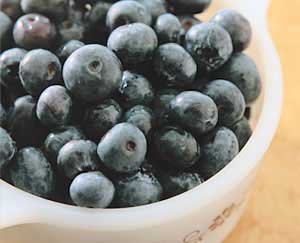Penn Herb Wellness Guide
Beautiful, Bountiful Berries

Savor one of summer’s sublime pleasures all year long with a dash of forethought and a pinch of preparation. Just a few simple steps will preserve some of this season’s jeweled treats to brighten your wintertime meals.
Freeze your finds
Freezing berries is a surefire way to preserve the integrity and nutritional content of fruit. For blackberries, boysenberries, marionberries, loganberries, and raspberries, rinse fruit and drain. Blot them dry on dishtowels and freeze loosely on cookie sheets so they don’t clump together. Then seal in airtight freezer bags or containers.
Blueberries and huckleberries have to be treated a little differently. Rinse and drain them but then tenderize the skins by steaming them for 1 minute before sinking them into cool water. Freeze them as above.
For strawberries: rinse, drain, and remove hulls. Leave them whole or slice them so they are ready to add to hot cereals, muffins, and so on.
Turn berries into savory or sweet condiments
Drizzle blueberry syrup on pancakes and waffles or spark your winter salad with a tangy raspberry vinegar.
Raspberry vinegar—Place 3 quarts (1.48 kg) of berries in a glass bowl and crush to release juices. Add 1 pint of white wine vinegar. Cover and let sit for 24 hours. Strain with a coffee filter, capturing liquid and discarding the berry flesh. Measure liquid and mix with equal amount of sugar. Place in saucepan, bring to a boil, and simmer 10 minutes. Remove from heat and let stand overnight. Decant vinegar into clean, dry bottles. Use it to dress salads, by itself or mixed with your favorite oil for a delicious vinaigrette.
Berry syrup—Combine 1 1/4 cups (296 ml) of berry juice, 1 1/2 cups (355 ml) sugar, 1/4 cup (59 ml) white corn syrup, and 1 tablespoon (15 ml) of lemon juice in a saucepan and bring to a boil for 1 minute. Remove from heat. Skim off foam and ladle into clean, hot jars. Store in your refrigerator for up to two weeks.
Discover the art of canning: jams and jellies
A simple combination of fresh berries, pectin, sugar, lemon juice, and water will yield sweet jams and jellies any time of year. “Use firm, ripe fruit and use the exact amount of sugar the recipe calls for to help your jam set,” says avid jam maker and mom to four kids, Lis Collins of Crested Butte, Colorado.
Try using your favorite type of berry or mix it up with a variety. Traditional canning requires some steps to ensure safety, which are easily learned from books or Web sites. Or call your local community education extension to find out about their food preservation or canning classes.
For an introduction to canning, try a simple, no-cook freezer jam:
- Wash and mash 2 quarts (.98 kg) of fresh raspberries or strawberries.
- In a large saucepan, measure 3 1/4 cups (.04 kg) pulp. Add 1/4 cup (237 ml) lemon juice. Slowly stir in one 3-ounce (89 ml) packet liquid pectin. Mix thoroughly and then set aside for 30 minutes, stirring frequently to allow the pectin to dissolve.
- Add 1 cup of light corn syrup, and then add 4 1/2 cups (.85 kg) of white sugar, stirring well to dissolve completely.
- Warm mixture to 100F (38C) using a candy thermometer to confirm temperature. Let set for 10 to 15 minutes. Stir occasionally to keep fruit equally distributed.
- Pour in jars and seal. Refrigerate for up to one month, or freeze for up to one year.
Start to think about preserving early in the season: buy more berries than you can eat, stock up on freezer bags and canning jars, and you, too, can dine on strawberry shortcake in December and blueberry muffins in February. What better way to savor all that this fleeting summer season has to offer?
Copyright 2025 TraceGains, Inc. All rights reserved.


